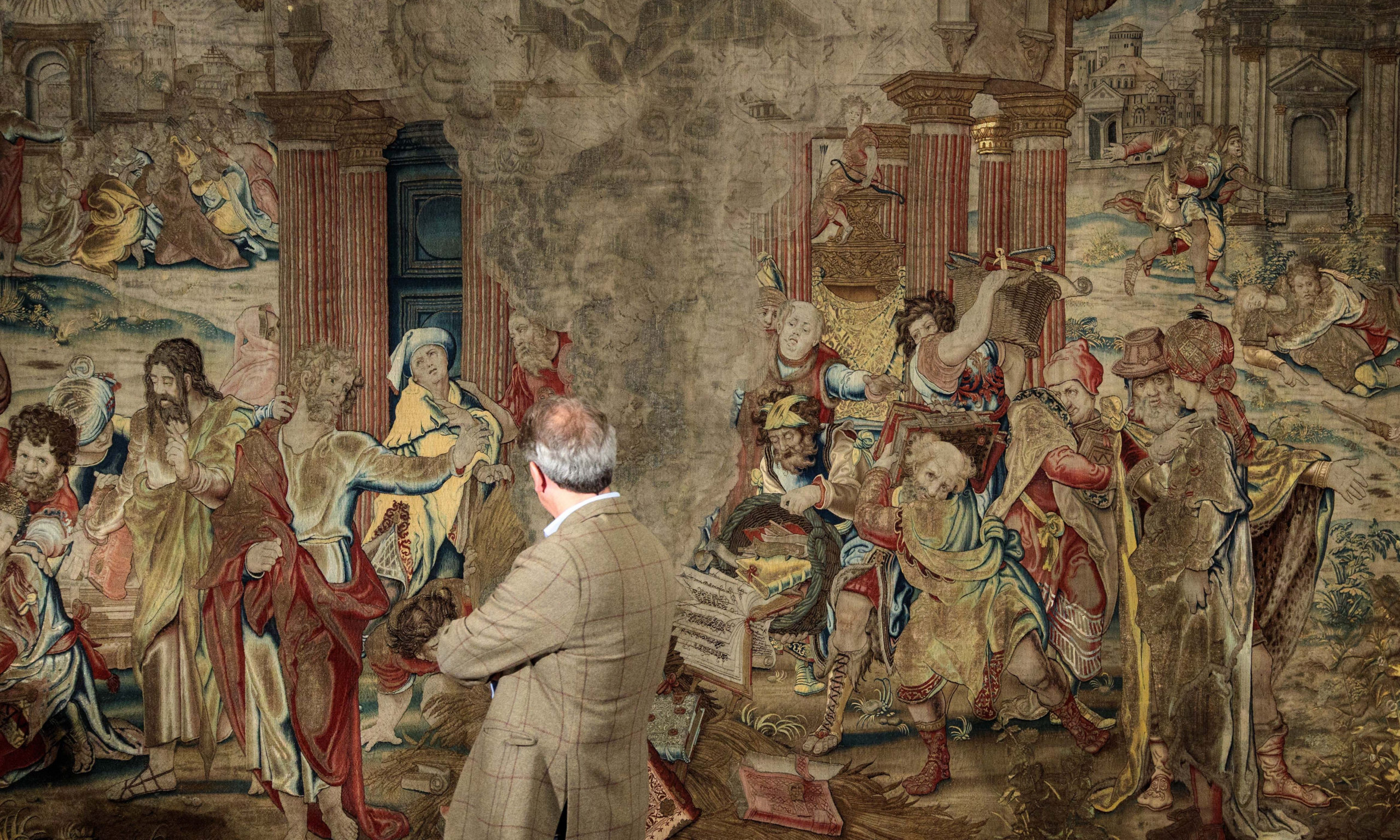The former director of the Metropolitan Museum of Art Thomas Campbell inspects a 16th Century tapestry depicting St Paul burning heathen books
Photo: Jack Taylor/Getty Images
A British businessman hopes to display in the UK a tapestry commissioned by Henry VIII which was thought to have been destroyed for more than 200 years. The work, created by the Flemish artist Pieter Coecke van Aelst, was described by Thomas Campbell, former director of the Metropolitan Museum of Art in New York, as the “Holy Grail of Tudor tapestry”.
The tapestry, entitled Saint Paul Directing the Burning of Heathen Books, is currently in Spain subject to an export ban—although Spain is willing to make an exception for an "appropriate institution" in the UK. The financier Jonathan Ruffer wants to show the piece in the new Faith Museum launching in October at the Auckland Project in the UK's County Durham, an institution he has founded.
Writing in The Spectator last month, Ruffer said: “There was rejoicing that Joshua Reynolds’s Portrait of Omai had been saved for this country at a cost of £50m. My hat was in the air with everyone else’s. But much less attention has been given to another artwork in need of rescuing, one of far greater national and artistic importance: an object that proclaims the birth of the Church of England—and is available for less than a tenth of the cost of Omai.”
Ruffer has launched a crowdfunding campaign with the aim of raising the last £1m required to buy the tapestry (it is unclear how much has so far been raised; an application for funding will also be made to the UK’s National Heritage Memorial Fund). According to the 2019 Sunday Times Rich list, Ruffer was worth £159m; the same year he also topped the newspaper’s “giving list” handing out donations totalling £317.5m.
Van Aelst’s work—the sole survivor of a series of nine tapestries that the infamous monarch commissioned in the mid-1530s on the life of Saint Paul—was thought to have been destroyed. But in 2014 the gold-embroidered tapestry was discovered in a Spanish private collection.
The Spanish government, keen to place the tapestry in a UK institution, is selling the work for £3.5m, plus £1m in export taxes according to The Guardian. “Did Britain roar into life at this extraordinarily generous offer? Nope. It was made four years ago, and one-by-one the invitation to the feast has been rejected by UK institutions,” Ruffer writes.
Ruffer believes the tapestry can be centrepiece at his Auckland Project. He is the main backer behind the project, a hub of heritage gardens, galleries and gardens which was once the ancient seat of the prince bishops of Durham. The Spanish Gallery, part of the complex, is home to paintings by 16th-century Spanish Golden Age artists (it also houses works owned by Ruffer).
The Faith Museum, located in the 14th-century wing of Auckland Castle, will show items such as the Binchester ring, excavated in 2014 at the Vinovium Roman fort, and a copy of William Tyndale’s English translation of the New Testament from 1536. Contemporary commissions by artists such as Mat Collishaw and Khadija Saye, who died in the Grenfell Tower fire, will also be included.
Ruffer explains why the new museum is the best home for the tapestry. “One of the Prince-Bishops of Durham was Cardinal Wolsey, whose failure to win the Pope’s cooperation set in train the events that ended in the creation of our national church… We also have one of the seemingly only 14 Tyndale Bibles to survive the holocaust. This provides the context, but, being fresh to the task, we have what none of the great institutions can bring to bear: the space to house such a magnificent object."

